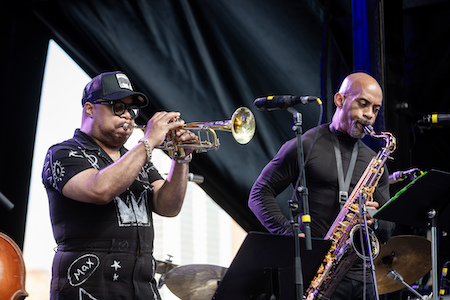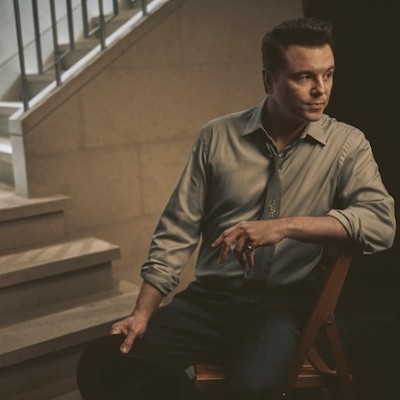Dec 9, 2025 12:28 PM
In Memoriam: Gordon Goodwin, 1954–2025
Gordon Goodwin, an award-winning saxophonist, pianist, bandleader, composer and arranger, died Dec. 8 in Los Angeles.…

Nicholas Payton, left and Tim Warfield, performing at last year’s Pittsburgh International Jazz Festival, demonstrate the event’s dedication to great jazz.
(Photo: Joey Kennedy)When jazz fans think about great American cities for this music, Pittsburgh may not be high on their list. But it should be.
Consider the giants who were born, raised and established their careers there. Earl Hines. Ahmad Jamal. Art Blakey. Billy Strayhorn. Ray Brown. Mary Lou Williams. Billy Eckstine. For good measure, add Erroll Garner, Kenny Clarke, George Benson, Stanley Turrentine and Jeff “Tain” Watts. All from Pittsburgh.
Not to mention local legends who made an outsize impact, like drummer Roger Humphries, who came back to his hometown to play and teach after performing with Turrentine, Ray Charles and Horace Silver. Or pianist Johnny Costa and guitarist Joe Negri, both of whom found fame playing on Mr. Rogers Neighborhood, filmed in Pittsburgh.
That legacy is never far from the mind of Janis Burley Wilson, who runs the Pittsburgh International Jazz Festival. Wilson is president and CEO of the August Wilson African American Cultural Center (AWAACC), which celebrates the life and works of the playwright and has sponsored the festival since 2017. Wilson (no relation to the playwright) founded the festival in 2011 when she was with the Pittsburgh Cultural Trust. She is one of the very few women running or curating a major jazz festival in the U.S.
The festival’s 14th edition will be held Sept. 19–22. “This year we’re taking it back home to downtown and the August Wilson Center,” Wilson told DownBeat, “to celebrate the 15th anniversary of the opening of the center in 2009. For the first 10 years, we held the festival in the streets of downtown, and it was free. After the pandemic, however, we made it a ticketed event, where we could check for proof of vaccination. But this year a large percentage of the festival will be free, in addition to some ticketed events.”
Wilson reminisced fondly about great moments from previous Pittsburgh festivals: “Chick [Corea], Christian [McBride] and Brian [Blade] for free in the street; Gregory Porter for the first time in 2011, when nobody knew who he was; the sons of Roberto Clemente, a Pittsburgh baseball legend, introducing El Gran Combo de Puerto Rico on stage — probably the most popular salsa orchestra in the world.”
Artists announced for this year’s fest include Robert Glasper; Endea Owens & The Cookout; the Emmet Cohen Trio; Sean Jones; The Average White Band (AWB), who have played the festival several times and are on their “farewell tour”; the Dan Wilson Trio; and Orrin Evans and his Captain Black Big Band. Many more are expected to be announced in the weeks to come.
The festival will kick off with a “Taste of Jazz” party at the Center with a homecoming theme, featuring jazz artists on several stages throughout the building, as well as food stations serving up fare from some of Pittsburgh’s finest restaurants.
Wilson said she is also bringing back a popular feature from last year’s festival: the “Jazz Train,” a reserved car on Amtrak’s New York–Newark–Philadelphia–Pittsburgh run intended to entice jazz fans from major East Coast cities. Pianist Evans and his big band will return to host a jam session onboard. Also along for the ride will be singer Vanisha Gould, who will be the festival’s “emerging artist-in-residence.”
“We actually get started three weeks early,” Wilson said, “with a series of concerts throughout the city featuring local jazz musicians. We have so many amazing ones living and working right here in Pittsburgh. We want to honor them and the venues that present them year-round.”
Prior to 2011, Pittsburgh hadn’t had a major jazz festival since 2003. That’s when the Mellon Jazz Festival, which George Wein established in the 1980s, shut down after a 25-year run.
Wilson cites Wein as one of her mentors. “I was thinking just the other day, ‘What would George do?’” She had been wrestling with the question of whether to continue the recent tradition of ticketed events, which had largely been a response to the pandemic. “We had done it outside for free for years. Then we did our first virtual festival in 2020. We were the first to do that, and it worked. Then we had a virtual blues festival. So … now we’re going from street, to virtual, to ticketed and [mostly] back to street.
“George was famous for making changes to the formula and adapting to the times. I thought to myself, would he stick to the way we had been doing it for the last few years? No, he would adapt to the changing times.”
The legacy of jazz in Pittsburgh was the subject of a major documentary film, We Knew What We Had (2018), which has been shown on hundreds of PBS stations. The film — which includes marvelous performances by Hines, Jamal, Benson and others — recounts the city’s jazz history, especially in the neighborhood known as the Hill District, which had a thriving jazz scene for decades at clubs like the legendary Crawford Grill, before so-called “urban renewal” and the devastating riots of 1968 decimated it.
It took decades to rebuild the city’s jazz scene, according to jazz guitarist and arranger Marty Ashby, the executive producer of MCG Jazz (part of the nonprofit Manchester Craftsmen’s Guild), which manages the city’s premier concert venue for jazz as well as a jazz record label. Ashby, who has been a major promoter of jazz in Pittsburgh for 37 years, was a producer of the documentary.
Ashby said he, Wilson and a few other jazz promoters in town frequently cooperate and coordinate their work in the interest of furthering jazz in Pittsburgh. Today, the city’s thriving jazz scene is fed by several music schools offering jazz education, including Duquesne, Slippery Rock, West Virginia University and the Afro American Music Institute, he said.
Unlike some producers, Wilson and Ashby keep the focus on jazz and eschew big-name acts who have little or no connection with jazz. “Some festivals don’t have any jazz. We’ll never do that,” Wilson said. “I understand the economics of it, I get it, but jazz is always going to be the root of this fest. For example, the AWB is not a jazz group, but the music is heavily influenced by jazz. We want to be eclectic, so we can attract different audiences. But we’ll never have a little tiny stage with jazz groups, and then a giant stage with some pop act.” DB

Goodwin was one of the most acclaimed, successful and influential jazz musicians of his generation.
Dec 9, 2025 12:28 PM
Gordon Goodwin, an award-winning saxophonist, pianist, bandleader, composer and arranger, died Dec. 8 in Los Angeles.…

Flea has returned to his first instrument — the trumpet — and assembled a dream band of jazz musicians to record a new album.
Dec 2, 2025 2:01 AM
After a nearly five-decade career as one of his generation’s defining rock bassists, Flea has returned to his first…

“It’s a pleasure and an honor to interpret the music of Oscar Peterson in his native city,” said Jim Doxas in regard to celebrating the Canadian legend. “He traveled the world, but never forgot Montreal.”
Nov 18, 2025 12:16 PM
In the pantheon of jazz luminaries, few shine as brightly, or swing as hard, as Oscar Peterson. A century ago, a…

Dec 11, 2025 11:00 AM
DownBeat presents a complete list of the 4-, 4½- and 5-star albums from 2025 in one convenient package. It’s a great…

Seth MacFarlane takes a turn from his television and film career to sing arrangements made for Frank Sinatra, but never recorded.
Nov 18, 2025 12:04 PM
“I’m not gonna lie to you — I don’t know why I thought this was about The Naked Gun, but I’m happy it’s…